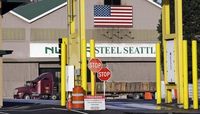European exporters are sounding alarms over the strengthening euro against the dollar, fearing it could exacerbate existing challenges posed by U.S. tariffs under the Trump administration. Companies such as SAP, Porsche, Heineken, and Schneider Electric have expressed concerns about the euro's recent surge, which has increased by over 9% against a basket of currencies, marking its highest value against the dollar since 2017. This appreciation threatens to undermine the competitiveness of European exports in the U.S. market, especially as American consumers tighten their spending amid uncertainties stemming from trade policies.
Mark Sefcovic, the European Commission's Vice President for Interinstitutional Relations and Foresight, warned that Trump’s plans regarding pharmaceuticals, semiconductors, and industrial products could impact a staggering €549 billion worth of exports from the EU to the U.S. This figure represents 97% of the total EU exports to America. Sefcovic highlighted that ongoing U.S. investigations into various sectors could lead to additional tariffs that would affect €170 billion of EU exports.
“If all these investigations lead to unjustified, harmful tariffs, then another €170 billion worth of EU exports to the U.S. would be impacted,” Sefcovic stated during a briefing with European lawmakers in Strasbourg.
Previously, the EU had estimated that a combination of a 20% tariff on semiconductors and a 25% tariff on automotive products, steel, and aluminum could affect 70% of the bloc's exports to the U.S., costing around $380 billion. Currently, the U.S. imposes tariffs of approximately €7 billion on EU exports, a figure that could soar to €100 billion if the ongoing investigations culminate in new tariffs.
Brussels is keen to leverage the temporary suspension of tariffs announced by Trump to negotiate new terms, though a basic tariff of 10% remains in effect despite the current reprieve from the 20% charge.
As the euro strengthens, companies are bracing for the financial implications. Dominik Asam, the Chief Financial Officer of SAP, indicated that every $0.01 increase in the euro-dollar exchange rate could decrease the company’s annual revenue by €30 million. Similarly, Heineken warned that the euro's rise against various currencies, including the Mexican peso, could cut projected profits by €180 million for the year.
Schneider Electric's CFO, Hilary Maxson, predicted that a weaker dollar, combined with other currency effects, could impact the company’s annual revenue by as much as €1.25 billion. Porsche, recognizing North America as its second-largest market, also acknowledged the unavoidable effects of a stronger euro on its bottom line, as stated by CFO Jochen Breckner.
HelloFresh has projected that its operational profits could be negatively affected by an exchange rate between $1.04 and $1.14 per euro, potentially costing the meal kit provider €28 million.
Trevor Greetham, head of multi-asset investments at Royal London Asset Management, noted that the combination of a strong euro and U.S. tariffs is leading many investors to reduce their exposure to European equities. This sentiment is reflected in the performance of European exporters, which have underperformed in the broader market amid the euro's rise.
According to Barclays, a basket of stocks that includes Stellantis, SAP, and Daimler Truck has lagged behind the overall European market as the euro strengthens. Analysts predict that the euro may continue to rise, potentially exceeding the $1.157 mark reached in April.
Amid these economic shifts, Athanasios Vamvakidis, Managing Director and Global Head of G10 FX Strategy at Bank of America, discussed the implications of U.S. trade policies at the 5th OT Forum. He indicated that the dollar's strength had initially seemed promising for markets, but the reality of Trump's policies has led to a decline in the dollar's value.
“The result was ultimately a drop in the dollar,” Vamvakidis concluded, while cautioning that uncertainty remains high regarding future exchange rates. The forecast suggests a potential rise to $1.20, but significant volatility is expected.
As European exporters navigate these turbulent waters, the interplay between currency strength and trade policy will be critical in shaping their strategies moving forward. With a potential trade war looming and the euro's ascent posing additional challenges, the coming months could prove pivotal for the EU’s economic landscape.




